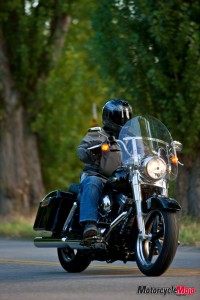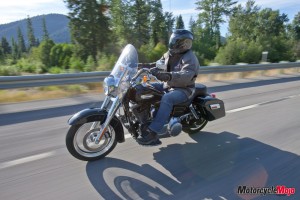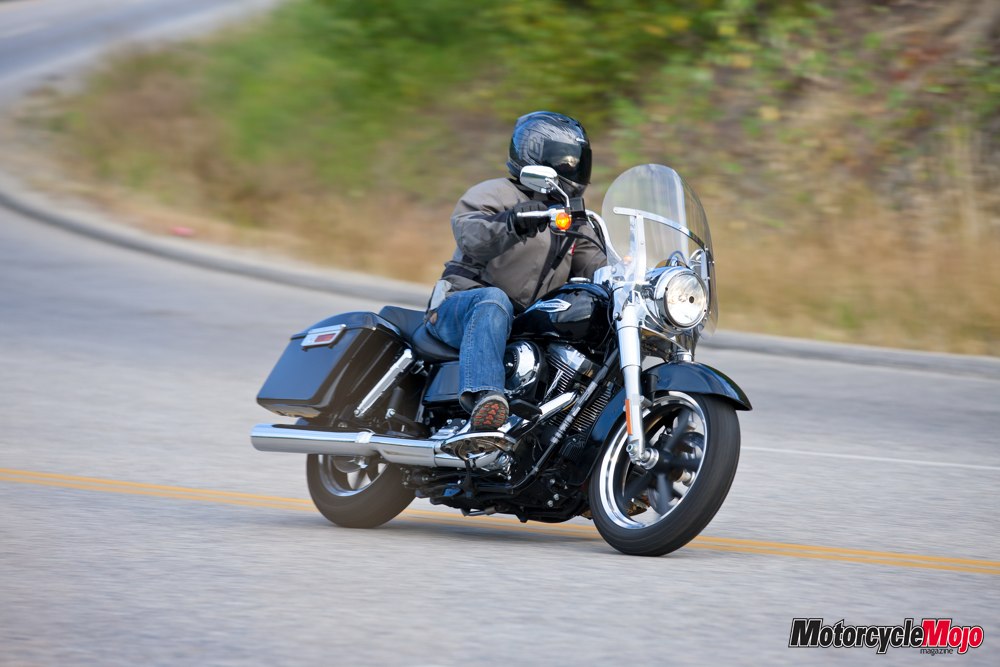Harley-Davidson’s longevity and unique history has allowed them to sell retro-styled bikes in record numbers over the past many years. For example, the hardtail frame and horseshoe oil tank from the ’30s, ’40s and ’50s bode well for today’s Softail sales, and the modern FL line takes its cues from the Electra Glide of the mid ’60s.
This is the genre that the new 2012 Dyna Switchback fits into. The Switchback bears a remarkable resemblance to the 1965 Electra Glide, albeit without the sprung saddle, but in a fully modern package. Its rounded hard bags follow the lines of the covered rear shocks, full-sized footboards, fuel tank–mounted console, windshield wrapped around the chromed headlight nacelle and chromed fork covers reaching down to the slightly smaller FL-style fender, all of which makes the Switchback very much like a mini version of the Road King. In fact, the cryptic model designation letters that Harley uses to distinguish family models for a Dyna have always begun with FX, until now. The model letters for the Switchback begin with FL, implying that it belongs to Harley’s FL touring family. Because it might be Harley’s smallest bagger to date, I wouldn’t be surprised if some even nickname it the Road Queen. While the Switchback would make an ideal ladies’ bike, seeing that the seat height is 45 mm (1.8 in.) lower and it’s a whopping 38 kg (84 lb.) lighter than the Road King, in no way should it be considered strictly a ladies’ motorcycle.
What was once reserved for the elite CVO line of Harley-Davidsons, the Twin Cam 103 now sits in the complete line-up of big V-twin Harleys, with the exception of a pair from the Dyna family, the Street Bob and the Super Glide Custom. According to Harley figures, the Twin Cam 103 pumps out 100 ft-lb (136 N-m) of torque at 3500 rpm, and considering that the Switchback is considerably lighter and much more nimble than a Road King, you might not want to call it a girl’s bike when the lady in your life beats you to the next stoplight or leaves you in the dust as she accelerates quicker out of a corner.
The Dyna line is the most sporting of the big-block Harley-Davidsons, and this agility lends itself nicely to a touring bike. Moreover, the Switchback is a versatile convertible, since the windshield and locking hard bags easily remove. Go from weekend bagger to boulevard cruiser in seconds, literally – it took me 29 seconds to remove both bags and the windshield. An ingenious mounting system easily sheds the bags; simply pull and turn the knob inside each bag and they slide off of the three mounting points. Once off, the mounting hardware is unobtrusive. The bag lids are a little awkward and require two hands to open and close, and care is needed to properly align the lids to the bags when latching.
Most people who ride a Harley like a little vibration from the engine – it’s a visceral reminder of the pair of big pistons pounding away between your legs – and the Dyna line has been designed to have just the right amount of vibration emitting from the rubber-mounted engine. My demo, unfortunately, had inordinate vibration beginning at 2700 rpm. Even though the bike handled perfectly, I theorized that the engine or the exhaust was out of alignment in some way. I later tried another Switchback and a Dyna Fat Bob, neither of which exhibited this vibration, leading me to believe my demo was an anomaly.
 The clutch lever is easy to pull and the friction point is predictable, as it is on all the big, V-twin, Harley 6-speeds. Equipped with just a toe shifter, the 6-speed Cruise Drive transmission shifts easily and power is delivered to the rear tire via Harley’s clean and quiet carbon-fibre drive belt.
The clutch lever is easy to pull and the friction point is predictable, as it is on all the big, V-twin, Harley 6-speeds. Equipped with just a toe shifter, the 6-speed Cruise Drive transmission shifts easily and power is delivered to the rear tire via Harley’s clean and quiet carbon-fibre drive belt.
The Switchback only has 98 mm (3.9 in.) of suspension travel up front and a measly 54 mm (2.1 in.) of movement out back but it delivered a firm but compliant ride. The 41.3 mm cartridge forks are not adjustable and the nitrogen-charged rear spring over shocks with adjustable preload and dual-rate spring did an admirable job of keeping away any spine-jarring jolts – even on rough pavement, the suspension never bottomed out. While the suspension did its job of keeping harsh pavement at bay, the 110 mm (4.3 in.) of ground clearance and only 29 degrees of lean angle make it easy for the hinged footboards to scrape pavement.
Apart from grazing the footboards a few times, the Switchback easily handled everything else I could throw at it, including switchbacks on my Rocky Mountain test track. A light push on the bar and the bike was happy to comply, effortlessly leaning into the turns. Thanks to the low centre of gravity, the Switchback was also a breeze to ride at slow speeds.
The Switchback’s floating 300 mm single disc and 4-piston fixed caliper up front makes easy work of stopping the bike with only a light squeeze on the lever. As with most cruisers, the rear brake also works well, as the 2-piston floating caliper squeezes its 292 mm rotor. For those who want ABS, it is available on the Switchback in the ABS/security package for an additional $1360.
Seating position on the Switchback is ideal for my 180 cm (5 ft. 11 in.) frame with my hands and feet falling naturally into place on the handgrips and footboards. The windshield blocked the lion’s share of the windblast and the top of the windshield was a perfect height for me at about 5 cm below my line of sight, but I did experience a little helmet buffeting at highway speeds. The dished seat is wide and supportive and will easily allow constant saddle time without fatigue between fill-ups on those long-haul days.
The view from the saddle is typical Harley. The detachable windshield wraps around the chromed headlight nacelle that gleams in the sunlight, while the short pullback risers direct the mini ape handlebar back to the rider for an easy reach. The fuel tank console, housing the analog speedo, warning lights and the ignition switch, is flanked by a pair of filler caps (the faux, left one is actually the fuel gauge).
Beginning with the ABS-equipped 2011 Softails, the Motor Company implemented a CAN-bus type electrical system that they call HDLAN (Harley-Davidson Local Area Network). This technology means far fewer wires – particularly handy in tight areas like the handlebar switches – which allows some of the buttons more functionality and to perform double-duty.
One of my pet peeves is a motorcycle without a tachometer, and while this is common to many Harley-Davidsons, the Switchback has this covered in a very discreet manner. In addition to its normal function, the horn button toggles upward to change the mode and reset screens on the LCD located at the bottom of the speedo housing. Now the LCD not only displays the odometer and a pair of trip meters, kilometres to empty, and a clock, but it also displays the gear selected and engine rpm. Other intuitive multi-function buttons include the high/low headlight switch, incorporating a passing light, and the starter switch, which toggles to activate the emergency flashers. All very cool and efficient, allowing you to keep your hands on the handgrips at all times.
All in all, Harley has hit the nail square on the head with the versatile Switchback. Fit and finish is excellent, it handles great, and the 103 engine puts the finishing touch on a fantastic all-round street bike. In essence, it is two bikes in one, and can be changed back and forth in just seconds. Whether it’s Vivid Black, Brilliant Silver Pearl or Ember Red Sunglo, the Switchback is as great a touring bike for many days on the road as it is a stripped-down cruiser for a main-street jaunt on a warm Saturday night.
| MODEL | 2012 Harley-Davidson Dyna Switchback |
| List Price | $18,169 black, $18,609 silver or red |
| Warranty | 24 months, unlimited mileage |
| Engine Type | Air-cooled, Twin Cam 103 V-twin |
| Displacement | 1691 cc |
| Power (claimed) | N/A |
| Torque (claimed) | 136 N-m (100 ft-lb) at 3500 rpm |
| Bore and Stroke | 98.4 x 111.1 mm |
| Compression Ratio | 9.6:1 |
| Fuel Delivery | Electronic Sequential Port Fuel Injection |
| Transmission | 6-speed |
| Final Drive Type | Carbon fibre belt |
| Front Suspension | 41.3 mm fork with 20 mm cartridgedamping and triple-rate spring |
| Rear Suspension | Nitrogen-charged 36 mm monotubedamper with 5-step preload adjustable
dual-rate spring |
| Wheel Travel | 98 mm (3.9 in.) front; 54 mm (2.1 in.) rear |
| Brakes | Front: 300 mm floating rotor with 4-piston fixed caliperRear: 292 mm rotor with 2-piston torque-free floating caliper |
| Wheelbase | 1595 mm (62.8 in.) |
| Rake and Trail | 29.9 degrees/148.3 mm |
| Tires | 130/70B-18 front; 160/70B-17 rear |
| Weight | 330 kg (727 lb.) in running order |
| Seat Height | 695 mm (27.3 in.) |
| Fuel Capacity | 17.8 L |
| Fuel Economy (observed) | 5 L/100 km (55.3 mpg) |
| Fuel Range (estimated) | 356 km |


























